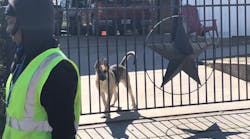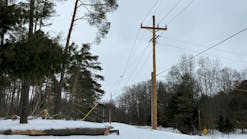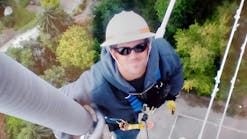By Keith Pancake
Like many of you reading this, I love my dogs, and dogs have always been a big part of my life. I may have downsized in breed type from Newfoundlands and black labs to a pug and a terrier, but my affinity for a dog’s unwavering love and loyalty has only grown.
Dogs are pack animals by nature, and our dogs undoubtedly accept us as a part of their pack. We offer companionship, food and shelter to our dogs, which gives them more than enough reason to protect us — fiercely at times.
By simply understanding the pack nature of dogs, we can prepare for and avoid most of the incidents and injuries that are a result of dog encounters.
Daily Exposure
Many of the positions within our industry present a daily opportunity of exposure to dogs and this is a continual concern to employers and employees alike. As such, positions like field services, meter reading and customer notification should place significant importance on dog bite prevention training.
Nearly 5 million people in the U.S. are bitten by dogs each year. Approaching any dog can have the potential for injury, but aggressive dog encounters are often serious, with the potential for much worse.
While there are tools and training available to teach the best techniques to avoid being bitten, there isn’t always a clear choice. I’ll offer some of my best management practices and in most cases, you’ll find aggressive dog encounter incidents can easily be avoided if we use common sense and practical judgment before entering a site where a dog might be found.
According to the American Veterinary Medical Association (AVMA), in 2018 39% of U.S. homes had dogs, which equates to over 48 million of the homes we visit to complete our work.
When approaching or entering properties where there are known dogs use your training to make a plan.
Communication Helps
Whenever possible, property owners should be notified before arrival, and after you depart. Explaining in detail the work you are performing and the length of time you’ll be present will also reduce the likelihood that the dog is unintentionally let out while you are still on the property.
Homeowners are understanding and appreciate the communication, as dog-attack incidents are an unwanted experience for them as well. If you’re approaching a home or yard, the best practice is to ask homeowners to secure any dog on the premises before you enter.
As dog lovers and owners — or simply because we are confident at our job, skills, and our ability to control situations — this can be a difficult step for many employees to take. Learn tactful ways to ask individuals to restrain their dogs and remember this step isn’t about your ego — it is about your safety.
Another challenge presents itself when we see dogs while on the job, such as passing on a sidewalk. Don’t pet or attempt to pet any dog, even if you think it may be friendly. Dogs often react quickly and may bite a hand before the hazard is realized. Always presume that an unfamiliar dog may see you as an intruder or threat.
In almost every dog bite prevention training, step 1 is recognizing the threat and seeing the hazard. This step can be challenging for several reasons, dependent on your role. These challenges include repetitive tasks, mindlessly following procedures, habits and assumptions, and overconfidence.
When we perform root-cause analysis after a dog-encounter incident, the four precursors previously mentioned are consistently present.
Throughout the workday, it takes a commitment to expending time and energy at every property, and that expense in our minds can come at the cost of productivity.
Detecting a dog
Evaluate any site you enter for the presence of a dog. If you’re unsure if there is a dog on-site, check for the telltale signs: “Beware of Dog” signs, food and water bowls, toys, chains or ties and worn trails in the yard.
It is usually easy to identify the items mentioned above, but here are a few of the less obvious signs to be aware of:
- Garage doors that are left slightly ajar
- Dog doors
- CLEAN UP AFTER YOUR DOG signs
Many homes with dogs are like my own, where there are no outward signs of dog presence. If you can’t research a property before arrival, sound your vehicle horn and listen for barking, or use a safety whistle, in the same manner, to alert potential dogs to your presence.
Never approach a strange dog, especially. After years of barking at passersby from behind a window or fence, dogs can experience barrier aggression. They act aggressively primarily because they are scared, excited, stressed or anxious.
Humans are a trigger that they are reacting to, and they can’t reach us due to the barrier. Dogs may even gain a false sense of confidence because most times we pass by as they bark, so when we unexpectedly don’t, or even walk into a property, the fear increases and an attack may ensue.
When aggressive animals are known or suspected:
- Whenever available, review any information on the property regarding “bad dog/aggressive animal” warnings before you attempt to enter the location. Once this documentation is known, call ahead to alert the property owners of your intention to visit the site.
- Avoid entering properties with animal warnings until contact is made with the property owners. Whenever possible, after visiting the property confirm the warning was legitimate and the information is correct. It is critical for the safety of other who may come after you to keep this information current and accurate.
- If someone is available at the property, discuss if they can secure the dog(s) before entering the property.
- If the owner refuses to secure the dog(s), other arrangements should be made, including rescheduling.
When aggressive animals are unknown:
- Before entering the property, conduct a site evaluation for the presence of dogs based on existing context clues, local knowledge, etc.
- Be prepared, review training and guidelines on reacting when surprised by aggressive animals.
- Where appropriate, products containing 1.35% capsaicin such as Halt 2 Dog repellent or another approved deterrent should be made available whenever an employee feels an aggressive dog may bite or become too close.
- Aggressive animal information shall be entered into the company or local utility “bad dog/aggressive animal” database for that location if these records are kept. When entering a site with a dog is unavoidable, workers must minimize the potential for an attack and be prepared should it occur.
- Maintain awareness. Even if a dog is chained up, or is thought to be inside a structure, a dog may still be able to free itself. Never assume the owner has full control of a dog, even when leashed.
- Enter with caution. Before entering a yard, alert a potential dog to your presence: make some noise — rattling a fence, your keys, or sounding your car horn. Give the dog a chance to present itself. If it’s hot and they’re sleeping, or you are in a noisy environment, the noise you make must stand apart. Never disturb a dog while it’s sleeping, eating, chewing on a toy or caring for puppies. If you encounter a trapped dog in a corner, keep facing the dog and slowly start to back away, giving it an escape route. Entering a property and becoming cornered by a growling dog is a situation we can and must avoid. The effort you make takes little time and is proven to be effective.
- Approaching doors. Dog attacks often happen at front doors because we use them the most. Dogs have the advantage of being aware of your approach, and screen doors can be poor barriers. Larger dogs may be able to push through a solid door. Standing approximately 6 feet from the door and to the side upon approach allows you greater reaction time if necessary. A risky time for employees is when children are home, they sometimes aren’t situationally aware enough to hold the door and maybe too small to restrain an excited dog. Keep this in mind around holidays, in the summer and if a child greets you at the door.
- Self-defense. If a dog attacks, it is critical to minimize the possible damage. Cover your face, neck, and vital areas. Dog attacks almost always cause people to panic, fight the urge to turn and run, attempt to lock eyes, and firmly tell the dog “NO!” NEVER turn your back to a dog and run away, its instinct will be to chase you.
- Put something between you and the dog, such as a clipboard or hardhat. Lawn furniture, trash cans, and other loose items can serve as a quick barrier. Tools such as dog bite prevention sticks and sprays may be acceptable depending upon site-specific regulations.
- If the dog continues to approach, turn to the side and take a wide stance with your feet shoulder-width apart and knees slightly bent to minimize your exposure and absorb the impact. This also makes you a narrower target. Brace for impact and don’t let the dog get to your hands.
- Brace yourself to try to avoid falling. Make fists so the dog won't bite off a finger and cross your forearms across your chest. Be ready to protect your most vulnerable anatomy – the front of your torso from your groin to your throat — often a dog's primary target. If you do fall, curl into a ball and clasp your hands around the back of your neck. If you are bitten, resist the natural urge to try to pull away. This will just make the injury worse by tearing your flesh
- If you can’t turn to the side, raise a knee and try to meet the lunging dog in the chest. This will deflect the dog and wind them at the same time, giving you a window to escape.
Deciphering dogs’ body language
Just as we do, dogs rely on body language to express themselves and communicate, according to the AVMA. Being able to decipher dogs’ body language can provide context clues as to whether a dog is feeling stressed, frightened, or threatened.
Signs of aggression include efforts to make the dog look bigger:
- Ears positioned upward and forward
- Raised fur on the back and/or tail
- Vertical tail may be wagging very quickly
- Stiff, straight-legged stance
- Staring
- Growling, lunging, or barking
Signs of fear or anxiety include efforts to make the dog look smaller:
- Cowering and/or lowering of the head
- Repeated lip licking
- Tucked tail
- Flattened ears
- Yawning
- Avoiding eye contact
- Remaining very still
- Growling or snarling
If you are bitten or attacked by a dog
Rabies
Rabies is a disease caused by a virus found in the saliva of infected animals and transmitted to pets and humans through a bite or contamination of an open cut.
- Rabies can be carried by wild animals like raccoons, skunks, foxes, and bats, with dogs being the source of most human rabies deaths worldwide. In the Americas, bats, not dogs, are the source of most human rabies deaths.
- Rabid animals may act tame. They may also display strange or unusual behavior. They may act aggressive, avoid food and water, foam at the mouth, or have trouble moving.
- Rabies can be prevented in humans if medical treatment is begun soon after contact with the rabies virus. If left untreated, rabies is always deadly.
Local treatment
Rabies is a medical urgency, not an emergency — but treatment should never be delayed. One of the best ways to reduce the chance of infection involves washing the wound with soap and water (with thorough flushing) for a minimum of 15 minutes.
Medical attention should be consulted to determine whether vaccinations should take place. Decisions to vaccinate often depend on the type of exposure, the animal you were exposed to, and surveillance information on the area where the exposure occurred.
In the U.S., 1 in 5 people bitten by dogs requires medical attention. If bitten by a dog, the AVMA provides a checklist of things you should do.
- If the dog's owner is present, request proof of rabies vaccination, and get the owner's name and contact information.
- Clean the bite wound with soap and water as soon as possible.
- Consult your doctor immediately or go to the emergency room if it's after office hours.
- Contact the dog's veterinarian to check vaccination records.
- Contact the local authorities if you have difficulties verifying vaccination records.
Having a dog charge at and bite you can be a frightening experience but is also a preventable situation. Protect yourselves by reviewing best prevention practices and taking additional dog bite prevention courses throughout your career.


